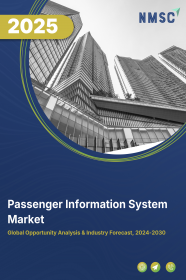
Passenger Information System Market by Component (Hardware, Software, and Services), by Solution (Information Display System, Announcement Systems, Infotainment Systems, Passenger Information Mobile Applications, and Emergency Communication Systems), and by End-User (Airway, Railway, and Roadway) – Global Opportunity Analysis and Industry Forecast, 2024–2030
Market Definition
The Passenger Information System Market size was valued at USD 28.55 billion in 2023 and is predicted to reach USD 60.29 billion by 2030 with a CAGR of 11.3% from 2024-2030. The Passenger Information System (PIS) market refers to the industry which is focused on providing real-time information to passengers in transit systems such as buses, trains, and airports. It encompasses technologies such as displays, announcements, mobile apps, and GPS tracking to enhance passenger experience, safety, and efficiency. These tools ensure passengers receive timely updates on routes, schedules, delays, and other relevant information, enhancing their overall travel experience.
Market Dynamics and Trends
The rapid increase in urban populations worldwide is driving the demand for better public transportation systems, leading to a surge in demand for the passenger information system market. These systems are essential for delivering timely updates to passengers, making their travel smoother and encouraging them to opt for public transit. With projections from the World Bank indicating 1.5 times increase in the global urban population to 6 billion by 2045, the importance of passenger information system in meeting the growing needs of urban mobility becomes even more apparent.
Moreover, as governments worldwide increases investments in public transportation and enact regulations to enhance passenger safety, comfort, and convenience, the demand for passenger information system is on the rise. Initiatives such as the 7th UN Global Road Safety Week (15-21 May 2023), where the World Health Organization (WHO) advocates for increased funding in walking, cycling, and public transport for the health and sustainability benefits of the people underscore the importance of these systems in enabling safer and more sustainable transportation networks globally.
However, high implementation and maintenance costs associated with deploying passenger information system solutions act as a barrier for adoption, particularly for smaller transportation operators with limited budgets. On the contrary, the integration of big data and analytics in the passenger information system market is expected to create future opportunities in the market. Big data and analytics are will speed up the decision-making capacity and control the public transportation systems. By analysing large amounts of data about how many people are using transportation, traffic flow, and related factors, officials will be able to make smart decisions about how to adjust schedules or address maintenance requirements.
Market Segmentation and Scopes of Study
The passenger information system market is segmented on the basis of component, solution, end-user, and region. On the basis of component, the market is divided into hardware, software, and services. On the basis of solution, the market is classified into information display system, announcement systems, infotainment systems, passenger information mobile applications, and emergency communication systems. On the basis of end-user, the market is segmented into airway, railway, and roadway. Regional breakdown and analysis of each of the aforesaid segments includes regions comprising of North America, Europe, Asia-Pacific, and Rest of the World (RoW).
Geographical Analysis
North America holds the dominating share in the passenger information system market and is expected to continue its dominance during the forecast period. This is attributed to increasing government initiatives in the region aimed at enhancing transportation. The American government's focus on investing in transport infrastructure and promoting public transit through regulations is a significant contributor to the demand for passenger information system. These initiatives underscore the importance of improving commuter experiences and operational efficiency in the evolving transportation landscape. For instance, the Bipartisan Infrastructure Law ("BIL"), signed by the Government of U.S. in November 2023, allocates USD 1.2 trillion of federal funds towards transportation, energy, and climate infrastructure projects, further boosting the demand for passenger information system in North America.
Also, the growth in air travel in the North American region increases the demand for seamless connections between different transportation modes including taxis and buses, to facilitate travelers' journeys to their final destinations. PIS systems play a fundamental role in meeting this demand by providing real-time information to passengers, thereby enhancing their overall experience and ensuring smoother transitions between various modes of transportation. As passenger satisfaction and operational efficiency are crucial, airports and transportation authorities in North America are progressively investing in advanced PIS solutions to meet these needs. These investments are aimed at improving passenger satisfaction levels, optimizing operational processes, and enhancing the overall efficiency of transportation networks.
According to a report published by Airlines of America, the aviation industry in the U.S. is experiencing significant growth, contributing approximately 5% to the country's GDP, equivalent to USD 1.25 trillion in the year 2022. This growth underscores the importance of efficient passenger services and seamless transportation connections, further driving the demand for passenger information system in North America.
On the other hand, Asia-Pacific shows a steady rise in the passenger information system market due to the increasing broadband connectivity across the region, which enables seamless data transmission between transportation authorities, passengers, and various components of the transportation system. With improved broadband connectivity, transportation operators can deploy advanced PIS solutions that provide real-time information to passengers through digital displays, mobile apps, and online platforms. This allows for efficient collection, processing, and dissemination of data related to transit schedules, routes, delays, and other relevant information. This, in turn, contributes to the steady rise of the passenger information system market in Asia-Pacific. According to the Telecom Regulatory Authority of India, 2023, India is the world's second-largest pool of 825 million mobile broadband users. Moreover, each mobile data user consumes more than 17 GB of data per month on average, highlighting the significant role of broadband connectivity in driving the adoption of passenger information system in the region.
Moreover, the rise in government initiatives aimed at enhancing metro rail systems in the Asia Pacific region increases emphasis on passenger safety and security measures, which in turn drives the PIS market. PIS systems play a crucial role in providing emergency information and alerts to passengers during critical situations, enhancing overall safety measures within these expanding transportation networks. According to a Press Information Bureau (PIB) report, 2023, the Asian Development Bank (ADB) and the Government of India signed a USD 350 million loan aimed at constructing new lines and enhancing connectivity of the metro rail system in Chennai with the city's existing public transport system. Such initiatives underscore the importance of advanced communication and management solutions, driving the growth of the passenger information system market in Asia Pacific.
Competitive Landscape
The various market players of passenger information system market include Advantech Co., Ltd., Cisco System, Inc., Siemens AG, Cubic Corporation, Teleste Oyj, Mitsubishi Electric Corporation, Hitachi Ltd., Alstom SA, Passio Technologies, and Indra Sistemas S.A. These market players are adopting various strategies including launches to maintain their dominance in passenger information system (PIS) market.
For instance, in June 2023, Alstom launches automated monorail in Bangkok, Thailand, expanding its rail transportation offerings. This innovation contributes to the advancement of passenger information system within the public transportation sector. For instance, in August 2023, Hitachi Ltd. announced a significant order for their ERTMS digital signaling technology, aimed at enhancing rail connectivity and efficiency. ERTMS is known as the most advanced system for digital railway control which utilizes radio signals between trains and tracks to monitor speed and trigger emergency brakes if hazards or speed limits are exceeded. Luca D'Aquila, COO of Hitachi Rail Group and CEO of Hitachi Rail Italy, expressed pride in this order, highlighting that the ERTMS system will facilitate safer travel at higher speeds and enhance line capacity.
Moreover, in March 2023, Indra Sistemas S.A. announced to enhance flight capacity and safety in India through a pioneering system that centralizes all air traffic surveillance and management phases. This system will manage aircraft surveillance and control from departure to arrival at five major control centres and airports in India, enabling air traffic controllers to efficiently control traffic, enhance passenger safety, reduce delays, emissions, fuel consumption, CO2 emissions, and noise pollution.
KEY BENEFITS
-
The report provides quantitative analysis and estimations of the passenger information system (PIS) market from 2024 to 2030, which assists in identifying the prevailing market opportunities.
-
The study comprises a deep dive analysis of the passenger information system (PIS) market including the current and future trends to depict prevalent investment pockets in the market.
-
Information related to key drivers, restraints, and opportunities and their impact on the passenger information system (PIS) market is provided in the report.
-
Competitive analysis of the players, along with their market share is provided in the report.
-
SWOT analysis and Porters Five Forces model is elaborated in the study.
-
Value chain analysis in the market study provides a clear picture of roles of stakeholders.
KEY MARKET SEGMENTS
By Component
-
Hardware
-
Software
-
Services
By Solution
-
Information Display System
-
Announcement Systems
-
Infotainment Systems
-
Passenger Information Mobile Applications
-
Emergency Communication Systems
By End User
-
Airway
-
Railway
-
Roadway
By Region
-
North America
-
The U.S.
-
Canada
-
Mexico
-
-
Europe
-
The UK
-
Germany
-
France
-
Italy
-
Spain
-
Denmark
-
Netherlands
-
Finland
-
Sweden
-
Norway
-
Russia
-
Rest of Europe
-
-
Asia Pacific
-
China
-
Japan
-
India
-
South Korea
-
Australia
-
Indonesia
-
Singapore
-
Taiwan
-
Thailand
-
Rest of Asia Pacific
-
-
RoW
-
Latin America
-
Middle East
-
Africa
-
REPORT SCOPE AND SEGMENTATION:
|
Parameters |
Details |
|
Market Size in 2023 |
USD 28.55 Billion |
|
Revenue Forecast in 2030 |
USD 60.29 Billion |
|
Growth Rate |
CAGR of 11.3% from 2024 to 2030 |
|
Analysis Period |
2023–2030 |
|
Base Year Considered |
2023 |
|
Forecast Period |
2024–2030 |
|
Market Size Estimation |
Billion (USD) |
|
Growth Factors |
|
|
Countries Covered |
28 |
|
Companies Profiled |
10 |
|
Market Share |
Available for 10 companies |
|
Customization Scope |
Free customization (equivalent up to 80 working hours of analysts) after purchase. Addition or alteration to country, regional, and segment scope. |
|
Pricing and Purchase Options |
Avail customized purchase options to meet your exact research needs. |
KEY PLAYERS
-
Advantech Co., Ltd.
-
Cisco System, Inc.
-
Siemens AG
-
Cubic Corporation
-
Teleste Oyj
-
Mitsubishi Electric Corporation
-
Hitachi Ltd.
-
Alstom SA
-
Passio Technologies
-
Indra Sistemas S.A.




















 Speak to Our Analyst
Speak to Our Analyst
























